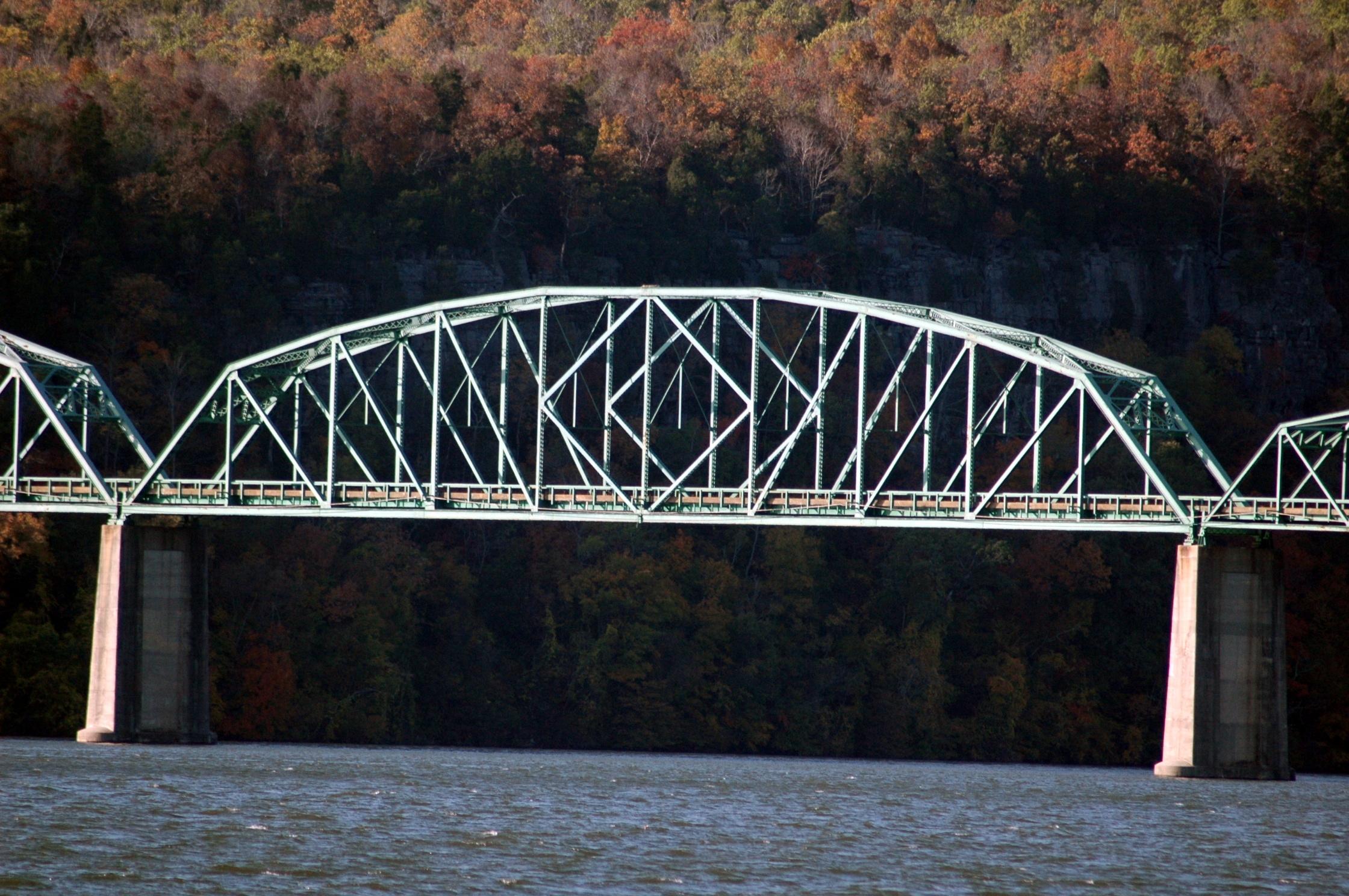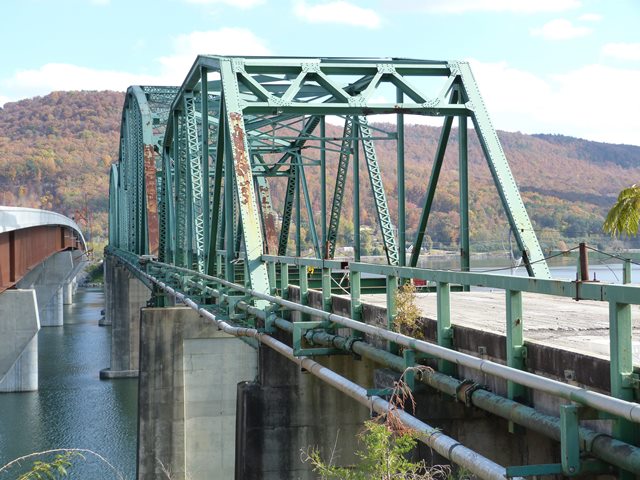We Recommend:
Bach Steel - Experts at historic truss bridge restoration.
BridgeHunter.com Phase 1 is released to the public! - Visit Now
Marion Memorial Bridge
Haletown Bridge

Primary Photographer(s): Nathan Holth
Bridge Documented: March 2007 and November 11, 2014
Dixie Highway (US-41/US-72/US-64) Over Tennessee River (Nickajack Lake)
Haletown: Marion County, Tennessee: United States
1966
360.0 Feet (109.7 Meters)
1,870.0 Feet (570 Meters)
20 Feet (6.1 Meters)
4 Main Span(s) and 20 Approach Span(s)
58SR0020023

View Information About HSR Ratings
Bridge Documentation
This bridge no longer exists!
View Archived National Bridge Inventory Report - Has Additional Details and Evaluation
This bridge was replaced and demolished in 2015!
View Historic Bridge Inventory Sheet For This Bridge
This beautiful bridge is historically significant for its large size, including an impressive approach system. The larger main spans are large also, at 360 feet. The smaller spans are interesting to look at. They are traditional polygonal Warren through truss spans, but a bit short at 140 feet, but next to the larger main spans, look quite tiny. Perhaps the most important aspect of this bridge however is the unusual design of the larger main spans. Although it appears to have been a standard plan in Tennessee, as evidenced by the similar TN-58 Bridge, which is doomed, the Haletown Bridge is extremely unusual today both nationally and within the state. The large spans are a modification of the Parker truss, whose two centermost panels utilize a truss arrangement that is like that found on a K-truss configuration. The K-truss is a highly uncommon truss configuration, mostly found in Oklahoma and is itself a noteworthy find. This unusual blend of the two configurations is just and unusual and noteworthy. In addition, the unique design of the truss creates a beautiful aesthetic design in which a clear diamond shape is visible when the bridge's elevation is viewed from a distance. Finally, the bridge is significant because it is on the Dixie Highway, which was an important early north-south highway, that remains today only in name on some of the roads this route once followed. The highway today is still regionally significant, serving several U.S. highways.
This bridge was a toll bridge until 1947. The 1966 rehabilitation date refers to a large project in which the bridge deck was raised by 57 feet to accommodate the higher waters caused when the Tennessee Valley Authority created Nickajack Dam. The approach spans appear to have been completely rebuilt at this time. Pre-stressed concrete, which is used on the approach spans was not a common material in 1929, but it was in use in the 1960s. As a result, the bridge has a rich history, one that tells the story not only of itself, but of the changing environment around it.
The bridge has a vertical clearance for vehicles of 14.6 Feet (4.45 Meters) and a navigational clearance below the bridge of 48.9 Feet (14.9 Meters).
Despite having an embarrassingly low number of remaining truss bridges, TDOT wants to demolish this beautiful historic bridge. Indeed, perhaps no other state has offered less of a commitment to the historic bridge community. One TNDOT official said they didn't expect than any metal truss bridges would remain in the state in the years down the road, with the exception of the Walnut Street Bridge in Chattanooga. Such a statement can mean only one thing: Tennessee intends to demolish every single highway truss bridge remaining in the state! This is an alarming statement, and highlights the need for the U.S. Congress to reinforce its declaration that preserving historic bridges is in the national interest, and expand existing limited preservation laws, that currently place little pressure on states like Tennessee to preserve their historic truss bridges.
The current federal laws for historic bridges do provide some limited protection and aid. If federal funds are used to replace a historic bridge, the owner must first market the bridge to a third party who may take the bridge to relocate and preserve elsewhere, or in some cases (like the Haletown Bridge) be able to simply preserve in place. That third party then has the choice of taking a sum of money up to the cost of demolition to put toward preservation, or alternatively, applying for a Transportation Enhancement Grant to help preserve the structure. These laws are a step in the right direction, and in the end might help the Haletown Bridge, but they generally do not go far enough to make a significant difference in the fate of historic bridges in the United States.
Fortunately, some people are saying enough is enough. Aware of the doomed TN-58, and the great potential the historic Haletown Bridge and surrounding scenic area has as a tourist attraction Paul Archambault, historic preservation planner with the Southeast Tennessee Development District wrote up a National Register of Historic Places nomination for the Haletown Bridge. His hope is to inspire a preservation project, one in which the historic structure would be left standing next to its replacement for pedestrian use. It is important that this bridge be saved, as it is a beautiful and unusual bridge in a state that has few metal truss bridges. It is an asset to the surrounding area, and as public interest in metal truss bridges gradually increases, the decision to preserve this bridge now will be one that people will be thankful for both now and down the road.
![]()
Photo Galleries and Videos: Marion Memorial Bridge
2007 Bridge Photo-Documentation
A collection of overview and detail photos by Dave Michaels. This photo gallery contains a combination of Original Size photos and Mobile Optimized photos in a touch-friendly popup viewer.Alternatively, Browse Without Using Viewer
![]()
2014 Bridge Photo-Documentation
Original / Full Size PhotosA collection of overview and detail photos taken after the replacement bridge was completeted and deck and approach span demolition was underway. However, this gallery includes a full detail set of the trusses. This gallery offers photos in the highest available resolution and file size in a touch-friendly popup viewer.
Alternatively, Browse Without Using Viewer
![]()
2014 Bridge Photo-Documentation
Mobile Optimized PhotosA collection of overview and detail photos taken after the replacement bridge was completeted and deck and approach span demolition was underway. However, this gallery includes a full detail set of the trusses This gallery features data-friendly, fast-loading photos in a touch-friendly popup viewer.
Alternatively, Browse Without Using Viewer
![]()
Maps and Links: Marion Memorial Bridge
This historic bridge has been demolished. This map is shown for reference purposes only.
Coordinates (Latitude, Longitude):
Search For Additional Bridge Listings:
Bridgehunter.com: View listed bridges within 0.5 miles (0.8 kilometers) of this bridge.
Bridgehunter.com: View listed bridges within 10 miles (16 kilometers) of this bridge.
Additional Maps:
Google Streetview (If Available)
GeoHack (Additional Links and Coordinates)
Apple Maps (Via DuckDuckGo Search)
Apple Maps (Apple devices only)
Android: Open Location In Your Map or GPS App
Flickr Gallery (Find Nearby Photos)
Wikimedia Commons (Find Nearby Photos)
Directions Via Sygic For Android
Directions Via Sygic For iOS and Android Dolphin Browser
USGS National Map (United States Only)
Historical USGS Topo Maps (United States Only)
Historic Aerials (United States Only)
CalTopo Maps (United States Only)



